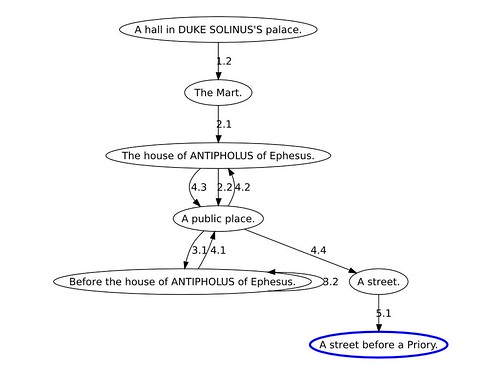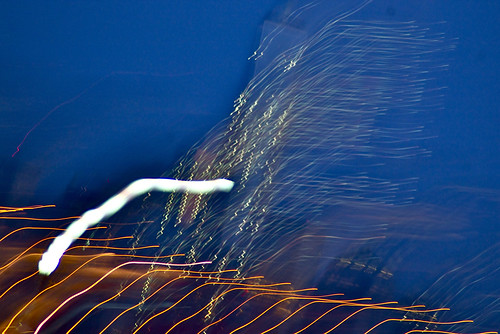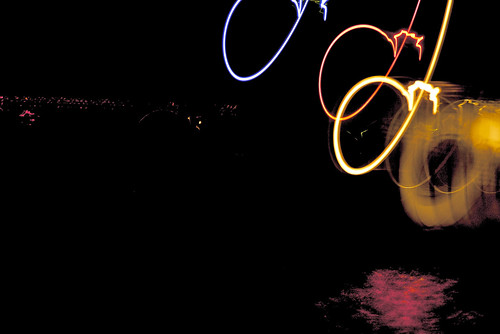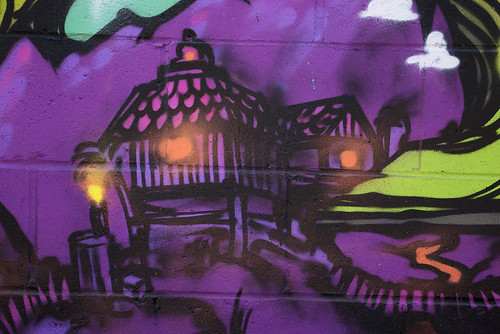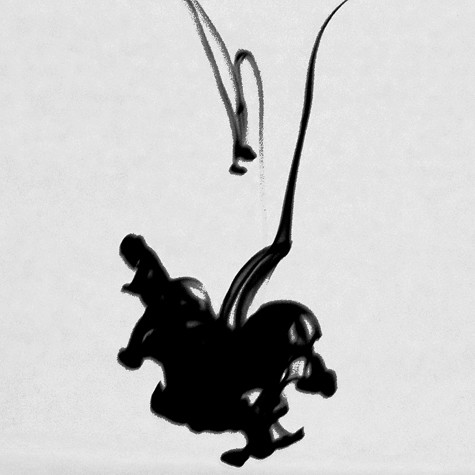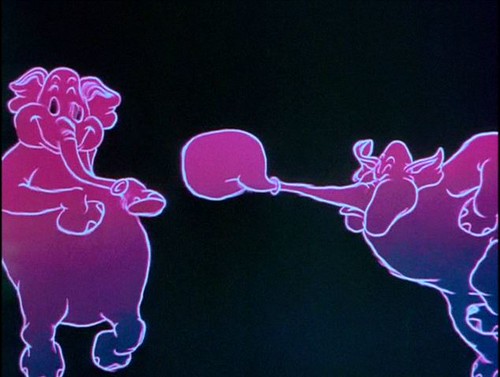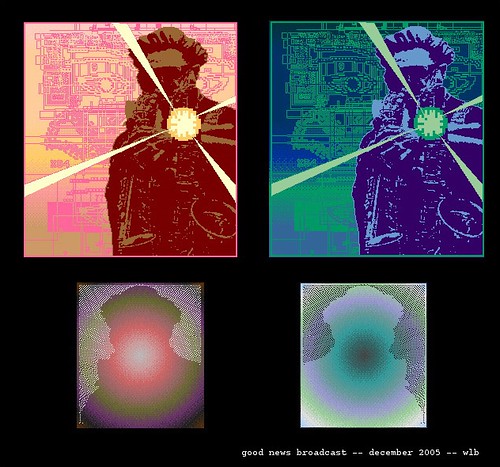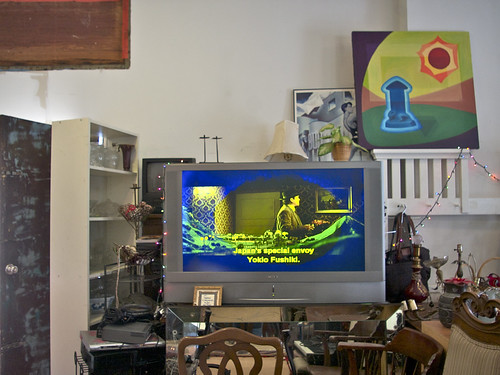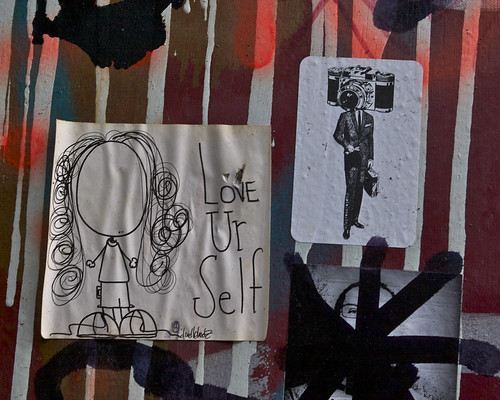Thursday, July 31, 2014
Duality: Norm Holland on Princess Mononoke
Norm Holland's been watching Miyazaki. Here's his take on Princess Mononoke:
There is no “bad guy” in this anime (unlike the usual Disney scenario). The wolf-god Moro can express a gentle melancholy, “I sit here and listen to the pain of the forest,” but she can also furiously attack the rice convoy and other mortals. Even Jiko, mercenary and greedy as he is, helps Ashitaka in the village and aids his escape from a trio that wants to steal the gold he may have.The Forest Spirit exists in a day form and a night form. It (or she or he) has an animal’s face and body but human eyes. It can give life and take it away—the flowers and plants that sprout from his footsteps and then wilt. His day form is benign. His Night Walker version is scary. That is to say, life and death—so paired, they are scary. So far as he is concerned, the ending is ambiguous. San says the Forest Spirit is dead, but Ashitaka declares that it will never die. And I suppose we have to accept the duality.Sometimes there is fighting between the “other” world and “our” world, but we can hope for harmony as in the finale. We are to accept these dualities with love and respect for their very difference. The film leaves us with the separation of the lovers, the forest’s San and the town’s Ishitaka. They will live separated, but at peace with the difference between them. They will lovingly visit from time to time.
Is there a "good Anthropocene"?
Clive Hamilton speaks to the notion of a "good Anthropocene", one where, by doubling down on science and technology, humankind can come through the next centuries with little more than a few cuts and scrapes.
The techno-utopian vision depends on a belief that, with the advent of the new geological epoch, nothing essential has changed. This reimagined Anthropocene rests on a seamless transition from the fact that humans have always modified their environments to a defense of a postmodern “cyber nature” under human supervision, as if there is no qualitative difference between fire-stick farming and spraying sulfate aerosols into the stratosphere to regulate Earth’s temperature.
But:
But the idea of a good Anthropocene is based on a fundamental misreading of science. It arises from a failure to make the cognitive leap from ecological thinking—the science of the relationship between organisms and their local environments—to Earth system thinking, the science of the whole Earth as a complex system beyond the sum of its parts...The revolutionary meaning of Earth-system science is lost on the ecopragmatists. In reality, the arrival of the new epoch represents not merely the further spread of human influence across the globe but a fundamental shift in the relationship between humans and the Earth system—one in which human activity now accelerates, decelerates and distorts the great cycles that make the planet a dynamic entity. The radical distinctiveness of the Anthropocene lies in the fact that humans have become a novel “force of nature”, one that is shaping the geological evolution of the planet.
Wednesday, July 30, 2014
Pattern Update, Connections: Brandt & Ramsay, Jockers & Me, and Goertzel
Three brief notes. The first revisits Ramsay’s work on patterns in Shakespeare and suggests that a concept developed by Per Aage Brandt might augment that work in a perspicuous way. Then I look at work that Matt Jockers has done on sentiment analysis and suggest that I would augment some work I’ve done on Heart of Darkness. The last is a note about a mathematical approach to patterns developed by Ben Goertzel, an AI researcher.
Loci and Spaces
Roughly two months ago I put up a post on and article David Ramsay had done on plot structure in Shakespeare. He’d created graphs the depicted the movement of individual plays from one location to another, such as in this graph for Comedy of Errors:
Each node in such a graph represents a physical setting (a locus in my terminology) where action takes place. There are some loci where only one scene is set and other loci where several scenes occur. You can follow the action through a play by starting at the top (in this case) and following the edges in order, where the edges are labeled by act and scene.
Ramsay noted that different plays displayed different patterns, and explained a procedure by which, with the help of a graduate student, Bei Yu, he was able to classify the plays more or less in the traditional four categories – comedies, histories, tragedies, and romances – on the basis of the graphs alone, with no information about what actually happens at the various loci.
What do we make of THAT? Ramsay didn’t know. Nor do I, though I suspect the loci might not be ‘mere’ physical settings, but that they might have specific thematic valences or affordances.
Are We Causing the Sixth Extinction?
Over the past half-billion years, there have been at least twenty mass extinctions, when the diversity of life on earth has suddenly and dramatically contracted. Five of these—the so-called Big Five—were so devastating that they are usually put in their own category. The first took place during the late Ordovician period, nearly four hundred and fifty million years ago, when life was still confined mainly to water. Geological records indicate that more than eighty per cent of marine species died out. The fifth occurred at the end of the Cretaceous period, sixty-five million years ago. The end-Cretaceous event exterminated not just the dinosaurs but seventy-five per cent of all species on earth.
The significance of mass extinctions goes beyond the sheer number of organisms involved. In contrast to ordinary, or so-called background, extinctions, which claim species that, for one reason or another, have become unfit, mass extinctions strike down the fit and the unfit at once. For example, brachiopods, which look like clams but have an entirely different anatomy, dominated the ocean floor for hundreds of millions of years. In the third of the Big Five extinctions—the end-Permian—the hugely successful brachiopods were nearly wiped out, along with trilobites, blastoids, and eurypterids. (In the end-Permian event, more than ninety per cent of marine species and seventy per cent of terrestrial species vanished; the event is sometimes referred to as “the mother of mass extinctions” or “the great dying.”)
Once a mass extinction occurs, it takes millions of years for life to recover, and when it does it generally has a new cast of characters; following the end-Cretaceous event, mammals rose up (or crept out) to replace the departed dinosaurs. In this way, mass extinctions, though missing from the original theory of evolution, have played a determining role in evolution’s course; as Richard Leakey has put it, such events “restructure the biosphere” and so “create the pattern of life.” It is now generally agreed among biologists that another mass extinction is under way. Though it’s difficult to put a precise figure on the losses, it is estimated that, if current trends continue, by the end of this century as many as half of earth’s species will be gone.
Cultural Evolution is Accelerating
Tim Morton has a post on accelerationism. I made the following comment:
From a certain POV the long course of history is accelerating. The time from the emergence of speech to the emergence and rationalization of writing (among the elite and a specialized clerkhood) is measured in tens of thousands of years. The time from routine writing to the scientific revolution (and the printing press and capitalism) is measures in thousands of years. The interval from that to quantum mechanics, relativity and computing (Turing to von Neuman) is down to hundreds of years. What's going on now at the scale of tens of years?
For more see my site on Mind-Culture Coevolution.
Tuesday, July 29, 2014
Five Easy Pieces: Race in the Symbolic Universe
Another working paper: SSRN link: http://ssrn.com/abstract=2473235. The five pieces have been previously published on New Savanna, but the introduction is new.
❖ ❖ ❖
Abstract: How did Western culture get from Shakespeare’s Caliban to Bill Cosby’s Dr. Cliff Huxtable? This essay examines that trajectory by consider six imaginative works: Shakespeare's The Tempest, Twain's The Adventures of Huckleberry Finn, Forster's A Passage to India, Faulkner's Light in August, Zemeckis's Who Framed Roger Rabbit, and The Cosby Show. The focus is on the projective dynamics of racisim where the racial Other is made to express feelings and desires that the dominant culture denies.
❖ ❖ ❖
The concept of freedom did not emerge in a vacuum. Nothing highlighted freedom—if it did not in fact create it—like slavery. . . . For in that construction of blackness and enslavement could be found not only the not-free but also, with the dramatic polarity created by skin color, the projection of the not-me. The result was a playground for the imagination. What rose out of collective needs to allay internal fears and to rationalize external exploitation was an American Africanism—a fabricated brew of darkness, otherness, alarm, and desire that is uniquely American.
– Toni Morrison, Playing in the Dark
There's a young black boy on my job and those white cats have made him tell them so many lies about what they call his love life that he can't tell whether he's coming or going. They want to believe that we screw like dogs or cats--you know, just go out there and get you a piece, just like they might scratch their backs or get a glass of water. . . Another thing, if we were just like dogs, then all the rotten things they have done and are doing to us would be okay!
– Clifford Yancy, in John Langston Gwaltney, Drylongso
Introduction: A Universe of Symbols
Each culture has a universe of symbols through which its members understand themselves and one another. We use these symbols to elaborate our mental world and to communicate with one another, for symbolism gives graphic and linguistic form to our feelings and desires. The olive branch and white dove of peace, the blood-red planet Mars betokening war, the serpent of wisdom, or of life and healing, are examples of such symbols. American society is culturally diverse. While all Americans may share some symbols–perhaps the American flag, the Thanksgiving turkey–other symbols belong to specific cultures. Each subculture has its own symbolic universe, with its own symbols.
European-American culture includes a vast network of symbols, a network in which African-Americans have played, and continue to play, an important role. The way whites symbolize blacks has more to do with the hearts and minds of whites than it does with black reality. Thus if we are to understand the role that black culture has played in the development of general American culture, we will need to understand the role that white culture has already assigned to blacks. The subject is vast, but we don’t need to survey it all in order to get the lay of the land. A few examples will serve.
Monday, July 28, 2014
Discussing interesting things...
The following twitteration reminds me of discussions we used to have about The Valve behind the scenes:
The Valve, as some of you know, was a group blog around and about literature. But we had a tough time discussing literary texts, though some of our readers wanted us to and would ask us to. I figured the problem was that, although we were all interested in literature, out specific interests in texts were different. While we could all talk some kind of theory, we weren't generally prepared to talk about one antoher's favorite texts. So, we defaulted to theory.
@scott_bot @mljockers But the tech really IS interesting, no? And so, how I came to love coding R is a conversational natural.
— Bill Benzon (@bbenzon) July 28, 2014
@scott_bot @mljockers everyone's interested in tech, but perhaps not in what everyone else is doing w/ it; so discuss the tech.
— Bill Benzon (@bbenzon) July 29, 2014
The Valve, as some of you know, was a group blog around and about literature. But we had a tough time discussing literary texts, though some of our readers wanted us to and would ask us to. I figured the problem was that, although we were all interested in literature, out specific interests in texts were different. While we could all talk some kind of theory, we weren't generally prepared to talk about one antoher's favorite texts. So, we defaulted to theory.
Reading Hyperobjects at 3QD: A Quake in Being
My latest post is up at 3 Quarks Daily, and it’s a review-essay on Hyperobjects: Sing Me a Song of Hyperobjects: Starting over with Humans and Other Creatures in the 21st Century CE.
In the process of writing that piece I had, of course, to run back through the book. Near the end of the process, too late to take account of it in the article, I was struck by the title of Morton’s introductory chapter, “A Quake in Being.” He introduces the phrase on page 19:
The discovery of hyperobjects and OOO are symptoms of a fundamental shaking of being, a being-quake. The ground of being is shaken. There we were, trolling along in the age of industry, capitalism, and technology, and all of a sudden we received information from aliens, information that even the most hardheaded could not ignore, because the form in which the information was delivered was precisely the instrumental and mathematical formulas of modernity itself. The Titanic of modernity hits the iceberg of hyperobjects.
Catchy, yes, very.
But what does it mean, this quake in being? The phrase evokes an earthquake, when the ground shakes beneath your feet and the earth opens up and starts swallowing without apparent end. Very dramatic. But what’s that have to do with Being? BTW, what’s this Being anyhow?
Mustart at GV002
Mr. Mustart has a piece at the new Green Villain mural, GV002, on Fairmount in JC. Here's a shot of the piece, and some details. You can see shots of the whole mural at last month's post on 3QD.
Sunday, July 27, 2014
The James Brown Biopic is on the Way to a Theatre Near You
Nelson George on James Brown in the NYtimes:
An immense ego strove to mask any insecurity. His drive to succeed was as unrelenting as his dancing. During the civil rights movement, he emerged as a leader capable of preventing a riot in Boston after the assassination of the Rev. Dr. Martin Luther King Jr. But he was also an eccentric, who would give up his processed hair for an Afro during the “Black Is Beautiful” era, only to return to the retro style because he loved having straight hair.“Get On Up,” directed by Tate Taylor from a clever screenplay by the brothers Jez and John-Henry Butterworth, attempts the difficult task of capturing a driven artist whose career spanned six decades and whose public persona overshadowed his inner life. Just as hip-hop would take break beats from the middle or end of Brown’s records to make new sounds, the Butterworths eschew a linear structure, jumping from 1988 to 1968 to 1938 and so on to put you at important turning points in Brown’s life.
The Obama era in American films:
It’s an interesting cultural phenomenon of the Obama presidency that a surprising number of films focused on black American history have both been financed and successful: “42,” “Django Unchained,” “The Help,” “Lee Daniels’ The Butler” and the 2014 Oscar winner for best picture, “12 Years a Slave.” In addition, two separate films centered on Nelson and Winnie Mandela have been released. A film about Jimi Hendrix is due in September. A biopic of Nina Simone has been filmed; a feature about the 1965 civil rights march that began in Selma just wrapped; one about Miles Davis is shooting now; and projects about the rap group NWA and the rapper Tupac Shakur are in the works.
All instruments are rhythm instruments (Yes indeed!):
No, the web doesn't destroy reading, and here's evidence
Escaping the Shallows: Deep Reading’s Revival in the Digital Age
DHQ: Digital Humanities Quarterly 2014
Volume 8 Number 2
David Dowling , University of Iowa
Abstract: Among the many reactions against the digital revolution is a humanitarian movement toward long form online reading in collective and social networks. This movement — visible in online book clubs such as "Infinite Summer" and 1book140, websites such as longreads.com, and the trend of blogs-to-books publication — is a reaction against superficial increasingly brief headline-driven Internet news. Called to action by the threat of what critic Jessica Helfand has diagnosed as digital culture’s "narrative depravation," the deep reading revival has reclaimed narrative and returned it to the populace, transforming reading into an act of mass collaboration on an unprecedented scale. Despite studies corroborating Nicholas Carr’s claim in The Shallows (2011) that the distractions of the digital environment are anathema to immersive linear deep reading, online culture has actually enhanced and accelerated the appreciation of longer richer works through its support of "radial reading" as described by Jerome McGann. This essay argues that while the intrinsically distracting virtual geography of the Internet has threatened to diminish the role of textured narrative in our intellectual and social lives, the Web has ironically provided the media for the most salient movements in support of the deep reading it threatens to obliterate.
Final paragraph:
Friday, July 25, 2014
Reading Hyperobjects 4: Digital Humanities Edition – High Dimensional Spaces and Descriptions
This may take awhile. After explaining my change in plan for this series I wade into phase space, complete with pictures illustrating an example of my own. What’s that got to do with the digital humanities? Easy: the search for hyperobjects. I then affirm Morton’s characterization of mathematics and conclude with a passage from Bethany Nowvitskie.
First, a change in plan
I’d planned on writing a commentary on each chapter, in order, with supplements. But the previous installment took more time than I’d expected. If that’s how things are going to go, then I don’t have time to follow through on that plan.
So, I’m skipping commentary on the “Temporal Undulation.” That means I’m not going to get to puzzle over Gaussian time and Einsteinian reference mollusks (the Wikipedia entry on Time fields in general relativity is useful here). But I’ll leave you with a two snippits.
From page 64, in his discussion of the Gaussian nature of hyperobjects: “The contemporary philosophical obsession with the monstrous provides a refreshing exit from human-scale thoughts.”
Concerning an example from the Islamic philosopher al-Razi, “Ignore the wrongness of this supposition, because it’s irrelevant” (p. 66). That’s good advice I find myself applying to Hyperobjects here and there.
Phase spaces, an example
Let’s skip to the next chapter, “Phasing,” where I want to concentrate on Morton’s definition of phase space and his account of math.
Morton defines a phase space as “the set of all possible states of a system” (p. 71). OK. But what does that mean? How do we work with such an object? How can we visualize it?
Let’s consider a system that’s somewhat smaller than earth’s weather system, the example Morton himself gives, and look at it with some care and a bit of detail.
Thursday, July 24, 2014
Reading Hyperobjects 3: Are We Are Poems about the Earth?
Before considering the subtitle of today’s post, which is derived from the last sentence on page 51 of the thirteenth page of “Nonlocality”, I want to examine the first paragraph, just to examine what’s in there, with some care and attention to detail. First I’ll quote the paragraph in full without commentary; then I’ll comment on it line-by-line.
When I look at the sun gleaming on the solar panels on my roof, I am watching global warming unfold. Carbon compounds and other molecules in the upper atmosphere magnify the burning intensity of the sun in the Great Central Valley of California. Yet I do not see global warming as such. I see this brilliant blade of sunlight, burning the top of my head as I watch it with half-closed eyes reflecting off the burnished, sapphire surface of solar panels. The manifold that I witness is not merely a “subjective impression,” but is rather just this collusion between sunlight, solar panels, roof, and eyes. Yet global warming is not here. Hyperobjects are nonlocal.
Microsoft Word tells me that paragraph has 93 words. Let’s go through it sentence by sentence.
1) When I look at the sun gleaming on the solar panels on my roof, I am watching global warming unfold: Three things, the sun, solar panels/roof, and global warming. An three spatial scales, the solar system at millions of miles, the earth at 10s of thousands of miles, and the house, at tens of feet. All linked by the fact that Morton is aware of them.
2) Carbon compounds and other molecules in the upper atmosphere magnify the burning intensity of the sun in the Great Central Valley of California: Morton now elaborates on warming and introduces a fourth scale, the microscopic scale of molecules and atoms; objects invisible to the naked eye; objects we think about only through scientific investigation and reporting. Action has shifted from Morton and his seeing to those molecules distributed about the upper atmosphere; they’re magnifying. And, by implication, he’s feeling the sun’s burning intensity. Morton closes the sentence by opening out on a fifth scale, the Central Valley: smaller than the earth, larger than the house.
3) Yet I do not see global warming as such: This sentence inserts a gap (a word Morton uses often, as in the gap between phenomenon and thing) between Morton, the observer writer, and global warming, his subject. He’s seeing something, and he knows global warming is somehow IN that something, but he really isn’t seeing global weather. Rather...
4) I see this brilliant blade of sunlight, burning the top of my head as I watch it with half-closed eyes reflecting off the burnished, sapphire surface of solar panels: Now we’re moving back into the conceptual space of the first two sentences, e.g. burning intensity of the sun (2), burning the top of my head (4); solar panels (1) solar panels (4). To this we add his head and his eyes, organs of sight.
Wednesday, July 23, 2014
Networks for Humanists
Just bumped into these today:
More Networks in the Humanities or Did books have DNA?: Elijah Meeks, a look at the use of networks in visualizing large textual datasets: "The network is not a social network or geographic network or logical network but rather a primitive object capable of and useful for the modeling and analysis of relationships between a wide variety of objects."
Digital Humanities Forum 2014: Nodes & Networks in the Humanities: Geometries, Relationships, Processes: A conference scheduled for September 12 & 13, 2014, at the University of Kansas. Conference on the 13th, workshops on the 12th. Registration is open.
See also my various posts on networks and, in particular, Toward a Computational Historicism. Part 1: Discourse and Conceptual Topology, where I discuss networks on three different scales.
More Networks in the Humanities or Did books have DNA?: Elijah Meeks, a look at the use of networks in visualizing large textual datasets: "The network is not a social network or geographic network or logical network but rather a primitive object capable of and useful for the modeling and analysis of relationships between a wide variety of objects."
Digital Humanities Forum 2014: Nodes & Networks in the Humanities: Geometries, Relationships, Processes: A conference scheduled for September 12 & 13, 2014, at the University of Kansas. Conference on the 13th, workshops on the 12th. Registration is open.
See also my various posts on networks and, in particular, Toward a Computational Historicism. Part 1: Discourse and Conceptual Topology, where I discuss networks on three different scales.
Beyond Quantification: Digital Criticism and the Search for Patterns
I've collected my recent posts on patterns into a working paper. It's online at SSRN. Here's the abstract and the introduction.
Abstract: Literary critics seek patterns, whether patterns in individual texts or patterns in large collections of texts. Valid patterns are taken as indices of causal mechanisms of one sort or another. Most abstractly, a pattern emerges or is enacted as some machine makes its way in an environment. An ecological niche is a pattern “traced” by an organism in its environment. Literary texts are themselves patterns traced by writers (and readers) through their life worlds. Patterns are frequently described through visualizations. The concept of pattern thus dissolves the apparent conflict between quantification and meaning, for quantification is but a means to describing a pattern. It is up to the critic to determine whether or not a pattern is meaningful by identifying the mechanism that produced the pattern. Examples from Shakespeare and Joseph Conrad.
Introduction: Patterns and Descriptions
There is a sense, of course, in which I’ve been aware of and have been perceiving and thinking about patterns all my life. They are ubiquitous after all. But it wasn’t until I began studying cognitive science with the late David Hays that “pattern” became a term of art. Hays and his students were developing a network model of cognitive structure – such works became common in the 1970s. Such networks admit of two general kinds of computational process, path tracing and pattern recognition. Path tracing is computationally easy, while the pattern recognition is not. Human beings, however, are very good at perceiving and recognizing patterns.
What put the idea before me, though, as something demanding specific thought, are remarks Franco Moretti made in coming to grips with his work on the network analysis of plot structure. In Network Theory, Plot Analysis (Literary Lab Pamphlet 2, 2011, p. 11) he noted that he “did not need network theory; but I probably needed networks.... What I took from network theory were less concepts than visualization.” We then examine the visualizations to determine whether or not they indicate patterns that are worth further exploration.
That, it seems to me, should put to rest fears about the incommensurability of numbers and meaning or, even worse, anxiety about infecting humanistic inquiry with quantitative evil. It’s not about numbers and counting. It’s about patterns. Numerical work is subordinate to and in service of looking for patterns, whether patterns in individual texts, as Moretti was doing in his work on plot structures, or patterns in collections of hundreds and thousands of texts spanning decades or more of historical time.
But, just what IS a pattern anyhow? How do we tell the difference between patterns and, well, non-patterns? Those are tricky questions, questions I pursue in the posts that make up this working paper. If what we’re looking for is some a priori way of specifying what patterns are so that we can then theorize about patterns in a general way, then I think we’re in trouble. In the sections, “Pattern” as a Term of Art and Patterns as Epistemological Objects, I suggest that there is no such thing. What emerges from those discussions is something like this: A pattern is something that emerges or is enacted as some machine makes its way in an environment in which it either survives or fails – where the italicized terms are understood in a very general and abstract sense. Thus understood, patterns are relations between machines and environments.
Reading Hyperobjects: Pardon Me While I Have a Strange Interlude
I’ve begun reading Morton’s second chapter, “Nonlocality,” and have decided I need to say something about Morton’s use of science, a subject matter that’s already occasioned a fair amount of discussion. Jon Cogburn’s written a useful post, How not to engage with other humanists; Nathan Brown and the continental/continental divide, which generated a great deal of discussion, much of it about Morton’s Realist Magic (which I’ve not read). Some thinkers are appalled by what Morton does and think it discredits his work. Others, while cognizant of difficulties, take a somewhat different view.
In reply to Cogburn, Terrence Blake said: “I do not discuss Morton at all as, like you, I think he is doing something very different than philosophy most of the time...” Others seem to agree; I’m one of them. In my own remark I observed that
I've been strongly influenced by Lévi-Strauss, an important precursor to (while also being contemporary to) much of the thinking in question. He made use of mathematical ideas. In particular, his four-volume study of myth is larded with technical-seeming diagrams, notation, and he talks of proving this or that in a mathematical way. But he also says, in the introduction to The Raw and the Cooked, that this is all by way of metaphor, analogy. He isn't really using algebraic group theory, but finds some notions from it useful.It seems to me that his use of those ideas is rhetorical and, in a way, necessary as well. The short-hand notions allow you to see relationships that cannot be expressed very well in prose. It's the visual layout and the way you can examine relationships among items as they're laid out on the page – very useful.
Reading Hyperobjects 2: What does real mean?
The question is from “Viscosity,” p. 32, and “real” is italicized. It’s a good question, one I often ask myself from within my own worldview – you’ll recall l concluded last time with a confession that I live a somewhat different ethos from the one through which Morton is writing, and so the answer I seek likely has a different valence and distribution. But I suspect we’re using those word forms under similar existential pressure.
* * * * *
The chapter opens:
I do not access hyperobjects across a distance, through some transparent medium. Hyperobjects are here...Like faces pressed against a window, they leer at me menacingly...From the center of the galaxy, a supermassive black hole impinges on my awareness (p. 27)
Don’t ask how it does that, for Morton tell us “as if... in the car next to me...” Just believe it and roll on.
Later:
Hyperobjects are agents. They are indeed more than a little demonic, in the sense that they appear to straddle worlds and times, like fiber optic cables or electromagnetic fields. And they are demonic in that through them causality flows like electricity. (p. 29)
Causality flows?
Bosh!
Why not? And you know, Disney was there long before he started doing PR for atomic energy (Our Friend the Atom). See:
Tuesday, July 22, 2014
A Corner Room at the Urban Design Center
The last time I visited the Urban Design Center it had been reduced to rubble, except for a corner room. Here's some shots of that room.
Reading Hyperobjects 1: The World has Ended
Timothy Morton. Hyperobjects: Philosophy and Ecology after the End of the World. University of Minnesota Press 2013. 229 pp.
I’m finding the book to be a bit of a tough read, requiring frequent pauses for thought. But more of that at the end.
* * * * *
I’ve finished the introduction, “A Quake in Being,” pp. 1-24.
A hyperobject could be the Lago Agrio oil field in Ecuador, or the Florida Everglades. A hyperobject could be the biosphere, or the Solar System. A hyperobject could be the sum total of all the nuclear materials on Earth; or just plutonium, or the uranium. A hyperobject could be the very long-lasting product of direct human manufacture, such as Styrofoam or plastic bags, or the sum of all the whirring machinery of capitalism. Hyperobjects, then, are “hyper” in relation to some other entity, whether they are directly manufactured by humans or not. (p. 1)
That quells some misgivings I had when Morton was explaining the concept at Stanford’s Arcade. At that time he seemed to dwell on weirdness, but the terms of his definition – hyperobjects are massively distributed in space and times, etc. – didn’t specify weirdness. But there’s nothing weird about the Solar System, or Styrofoam, or even capitalism, though it is perhaps a bit weird to think of all the world’s Styrofoam as one (collective) (hyper-)object.
You know how when you read Borges’ The Library of Babel you had little choice but to imagine books one might find there? There’s the one with a joke about three clergymen and a mosquito on page 79, but the punch line’s missing. The punch line is on page 123 in some other book, but in Klingon. And of course there’s a book containing the draft text of Hyperobjects, except that it reads right-to-left and back-to-front.
Monday, July 21, 2014
Body and Spirit: A Story of Fathers and Sons
David Hays and I talked of many things, not all of them intellectually serious. But intellectual seriousness was at the heart of conversations between us. Discussing intellectual matters with Dave had been a part of my weekly routine since graduate school. I want to share with you an almost-idea I had wanted to discuss with Dave at about the time he went into surgery, the surgery from which he never recovered.
This idea originated in introspection, as did many of the ideas we discussed. I had wanted to discuss it with Dave, first on general principle, but second because it seemed to have some relevance to a question he had pondered for a decade or more:
How is it that seeing ballet well-performed can have such a favorable effect on a person?
One could, of course, abstract from this question a more general one about the psychological effects of aesthetic experience. It would not be unfair to say that it is this more general question that “really” interested us. However, neither of us could see any way of getting to that more general question without analyzing particular kinds of aesthetic experience. Dave was drawn to the ballet while I was more drawn to literature and music.
The line I wanted to take up with Dave was prompted by the experience I had in writing a piece called “Fore Play: A Lesson in Jivometric Drumology” (and republished at New Savanna) The piece was in the style of, say, John Barth meets Richard Pryor, or Jorge Borges meets Lord Buckley, and purported to be about how golf was created by the ancient Egyptians. It started out as a satire of then current Afrocentric scholarship demonstrating that the ancient Egyptians were black in skin and culture, that the ancient Greeks were heavily indebted to those Egyptians, and therefore that Civilization originated in Africa. I don't command the scholarly literature on this issue and don't much care about it one way or the other. But the thinkers advancing the case for a black Egypt have something more at stake than simply correcting the historical record.
And my response to that “something more at stake” was to create a historical fantasy in which black Egyptians are the creators of golf, a notion which is far afield from anything which is, so far as I know, being argued seriously. In this fantasy golf is the creation of one Pharaoh Ramses Golfotep MCXLVII of the `N Baa Dynasty. He was inspired in this endeavor by a trumpeter named Daniel Louis Satchotep II, also known as King Toot. I leave it as an exercise to the reader to ponder the implications of some autobiographical facts: my father was an excellent golfer; I never took up the game; but I’m a pretty good trumpet player.
Writing this piece on the Egyptian origins of golf had a very strong effect on me. It is a short piece which went through a series of revisions over the course of about a week. During that week I was often convulsed in laughter, even awakening in the middle of the night to think about this absurd story and to laugh.
That is not all.
Sunday, July 20, 2014
Collective Creativity
At long last the venerable New York Times is beginning to catch up with New Savanna. I've been blogging about collective creativity for awhile now, and thinking about it for longer than I've been blogging about it, at least since I learned that Duke Ellington copped ideas from his men and built compositions around them – and I have the vague sense that that thinking predates Lincoln Collier's biography of Ellington. So I've been at it awhile.
Anyhow, they're running an op-ed, The End of 'Genius', by Joshua Wolf Shenk:
But the lone genius is a myth that has outlived its usefulness. Fortunately, a more truthful model is emerging: the creative network, as with the crowd-sourced Wikipedia or the writer’s room at “The Daily Show” or — the real heart of creativity — the intimate exchange of the creative pair, such as John Lennon and Paul McCartney and myriad other examples with which we’ve yet to fully reckon.Historically speaking, locating genius within individuals is a recent enterprise. Before the 16th century, one did not speak of people being geniuses but having geniuses. “Genius,” explains the Harvard scholar Marjorie Garber, meant “a tutelary god or spirit given to every person at birth.” Any value that emerged from within a person depended on a potent, unseen force coming from beyond that person.
After noting the proliferation of new world in social science and social neuroscience Shenk focuses on the pair:
The elemental collective, of course, is the pair. Two people are the root of social experience — and of creative work. When the sociologist Michael Farrell looked at movements from French Impressionism to that of the American suffragists, he found that groups created a sense of community, purpose and audience, but that the truly important work ended up happening in pairs, as with Monet and Renoir, and Susan B. Anthony and Elizabeth Cady Stanton. In my own study of pairs, I found the same thing — most strikingly with Paul McCartney and John Lennon.
Michael Nielson: The Artist and the Machine
From the post, which is about images produced through scientific instrumentation:
While Super-realism isn’t new, that doesn’t mean it’s yet in the artistic mainstream. Many people don’t consider works such as the Hubble Extreme Deep Field or the light-in-a-bottle video to be art. (I would not be surprised if this includes the creators of those works.) Even works more explicitly artistic in intent, such as Water in Suspense, are viewed as borderline. But I believe that each of these works reveals a new aesthetic, an aesthetic generated by the scientific principles underlying the phenomenon being represented. And insofar as they reveal a new aesthetic, I believe these works are art.
He concludes:
Super-realism has grown rapidly in the past twenty to thirty years. Three forces are driving that growth.First, far more people can access and learn to use scientific instruments. Recall Juan Geuer and his virtuoso home-made laser light show. There are people building everything from home-made bubble chambers to balloons exploring the upper atmosphere. These are not isolated curiosities, but rather part of a rapidly expanding social phenomenon that has been called by many names: the DIY movement, citizen science, the Maker movement. Whatever it is, it’s growing...Second, the data being taken by many of these instruments is being shared openly, online. In the 1980s if a scientist used a telescope to take a photograph, likely no more than a few dozen people would ever touch the photographic plate. Now more than a billion people can download data from the Hubble Telescope, and find new ways to visualize it...Third, we’re collectively building a powerful suite of tools to reveal these new worlds. For example, as I write there are more than 25,000 open source visualization projects available on the code repository GitHub. Most of those projects are, of coure, experiments that will be abandoned. But there are also many powerful tools that give people incredible abilities to make and reveal beauty. It’s no wonder Super-realism is flowering.Story-tellers say that reality is often stranger and more interesting than fiction. I believe this is true for all art. The reason is that nature is more imaginative than we, and as we probe deeper into nature, we will continue to discover new aesthetics and new forms of beauty. I believe these new aesthetics will stimulate art for decades or centuries to come.
Beyond Spindling and Mutilation: Shouldn't we recover machine translation for the digital humanities and thereby increase our imaginative scope?
Here's a nice standard-issue history of the digital humanities from NEH, tracing us back to Fr. Busa:
The story of digital humanities often begins with another theologian on a quest to make a concordance. In the mid 1940s, Father Roberto Busa, an Italian Jesuit priest, latched onto the idea of making a master index of works by Saint Thomas Aquinas and related authors. Busa had written his dissertation on “the metaphysics of presence” in Aquinas. Looking for the answer, he created 10,000 hand-written index cards. His work demonstrated the importance of how an author uses a particular word, especially prepositions. But making an index for all of Aquinas’s works required wrangling ten million words of Medieval Latin. It seemed an impossible task.In 1949, Busa’s search for a solution led him to the United States and International Business Machines, better known as IBM, which had a patent on the resources Busa needed to realize his project. Without the company’s help, his vision for a master concordance would remain just a dream.
But what of machine translation, that's almost as old?
I know, I know, the genealogy may spring from the same root, but its branches went in a different, very different, direction. But still, isn't translation a characteristically humanistic activity, one of the most fundamental? All those biblical texts translated into Latin and Greek, all those classical texts translated into modern European tongues, not to mention translations from Sanskrit, Mandarin, and all those other many tongues.
Perhaps it's too dangerous to reclaim that aspect of our heritage? Because then we'd have to follow computing deep into the heart of language and the mind.
But what of the soul, of the spirit? Do not fold, bend, mutilate, or spindle!*
Wouldn't want to do that, would we? The computer is a tool of the Devil. Why?
Because capitalism, because imperialism, because patriarchy, because racism! Because EVIL.
Still, computing is a child of the soul, an avatar of the spirit. What are we to do? Should we not reclaim it? Must we remain imprisoned in the 60s forever, an era when many of us were not even born?
Besides, if we're already using the computer to do back-room grunt work, then we've already entered the Devil's Workshop. We might as well look at our hands and see what they're doing to stave off idleness. Really, there's no way out. We're committed.
We need a properly revisionist history of our discipline.
Besides, if we're already using the computer to do back-room grunt work, then we've already entered the Devil's Workshop. We might as well look at our hands and see what they're doing to stave off idleness. Really, there's no way out. We're committed.
We need a properly revisionist history of our discipline.
*Some links: Free Speech Movement: Do Not Fold, Bend, Mutilate or Spindle, "Do Not Fold, Bend, Mutilate or Spindle": A Cultural History of the Punch Card.
Saturday, July 19, 2014
More on Blogging in the Academic Blogosphere: The Birth and Development of Object-Oriented Ontology
Much of the work on OOO (object-oriented ontology) was developed (and critiqued) in the blogosphere. Part of the critique was that you cannot properly do philosophy in the blogosphere. There’s an interesting and important article in this for some webwise graduate student.
The four thinkers most commonly associated with OOO maintain blogs (alphabetically): Ian Bogost, Levi Bryant, Graham Harman, and Tim Morton. Bogost blogs the least of the four, and has posted on the limitations of blogging for philosophy (“less blogging, more working”). Morton has cut way back on long-form posts in the last two years or so, but his early development of hyperobjects took place in the blogosphere. I believe that Harman drafted The Quadruple Object in a seris of blog posts, though I can’t provide citations, and has blogged about the importance of blogging to the movement, again, no specific links ready to hand.
Oppostion, often quite fierce, came from many quarters. But I’ll cite only two. There’s Agent Swarm, the blog of Terrence Blake, an independent scholar trained as a philosopher in Australia but who moved to France to attend seminars by Beleuze and Lyotard. An Und Für Sich is a theology-oriented group blog that hosted two very critical posts by Alexander Galloway; these posts generated fierce multifaced debate and are much referenced in the blogosphere. At various times and places you’ll find posts attempting to keep track of the current state of the debate by providing lots of links to recent posts.
Friday, July 18, 2014
Five Friday Fotos, Cosmos Series
Imagine a big bunch of photos arranged in a large multidimensional space where each dimension is some aspect of the image, whether subject matter (animal, vegetable, mineral, etc.) or form (messy, geometric, bright, redish, etc.). Photos that are like one another on some dimension are close together on that dimension. Photos that are generally like one another will be close together in the space.
Abstract, you say? Yes it is, and it’s done all the time in “big data” computing: classification and machine learning. But if that seems like gibberish, well, maybe it will begin to make sense when I start discussing the photos themselves.
Getting back on track. Imagine that I’ve arranged my photos in such a space. Now, I want to pick five photos such that they sample the space in way that usefully implies the whole space. That requires the photos to be quite different from one another.
[My argument that Disney's Fantasia is encyclopedic in scope is based on this idea, that in his choice of subjects, Disney sampled the space of human knowledge. You might also look at this post, Of Lists and Litanies, particularly set of screen shots from Miyazaki's Ponyo.]
I’ve picked five photos (below) with that in mind. Of course, I picked these photos according to my intuitive sense of the photos I’ve taken. I didn’t actually do any big data computing over them. But then, the mind does “big data” computing all the time. It might just be the case that that’s how the mind organizes large collections of objects.
The Value of Blogging and Social Media for Academics
I absolutely believe – see Alan Liu tweets below – that blogging and other social media can be invaluable for academics and, in particular, are central to the long-term revitalization of the interchange between the (humanities) academy and the public at large. (See my post, Alan Liu: Reengaging the Humanities.) For example, literature scholars could conduct reading groups for specific texts where the groups could be drawn from both "civilians" and academics from anywhere and everywhere.
I've been arguing that literary scholars need better descriptions (far more detail) of the texts we deal with. We need these descriptions for all the canonical texts and for a useful sample of the others. (See the crowd sourcing section at the end of my post, Some example descriptions: two poems, a novella, two manga texts, and two films; also, various posts on citizen science.)
Wednesday, July 16, 2014
Urban Design Center: the West Facade Evolves
I first photographed the Urban Design Center on July 25, 2011. I took a good many photographs in the following month, for coverage and to get a feel for the site. I then continued to photograph it at irregular intervals up to the present.
THAT's the point of photographing the same site over and over again, to show how the graffiti evolves. All of the photographs in this post show the west facade, which was almost empty the first time I photographed it, which was a month after I first began photographing this site. Initially there was little point in photographing this wall simply because there was so little there.
Judging from the water in front of the wall, and the date, just before Hurricane Irene hit Jersey City, I took this photograph, not so much to document the emptiness of the wall, as to document the rain water in front of it.
August 27, 2011
At this point the wall is pretty empty. You can see some large tags in the middle, and there's some stuff behind the trees at the right (the 2nd and 3rd photos in this post), but otherwise there isn't much here.
November 19, 2011
Except for the addition of a white throw-up (left of center) things haven't changed much by November.

The skyscraper to the left of center is the Goldman Sachs Building in downtown Jersey City. It was designed by César Pelli, an Argentinian American architect who is perhaps best-known for designing the Petronas Twin Towers in Kuala Lumpur, Malaysia. For awhile they were the world's tallest buildings.
Inside Sandy Looking Out
I took this photo the day after hurricane Sandy rolled through Jersey City. The power was out in my apartment and the City, of course, was pretty much shut down. So what else was there for me to do but to photograph the damage.
This particular building is a small abandoned industrial building of some kind; it's off Aetna Drive near the place where the old Morris Canal feeds into New York Bay. Since the building is covered with graffiti inside and out I call it the Urban Design Center. The hole in the wall was there before Sandy – I've taken several shots though it, looking in, and looking out – and the floor was trashed. But most of this debris seems have been washed through by Sandy.
What I particularly like about this photo is the electrical line and junction box that hangs down along the right side of the hole – the way it just hangs there, waiting? The branches reaching over from the left, and the City beyond in the mist. Notice the blue and red along the left edge of the photo. On a door I believe.
Tuesday, July 15, 2014
Book Review: The History of the Kiss! The Birth of Popular Culture by Marcel Danesi
The review in brief:
How should we make sense of the iconic act of the kiss? How and when did it become a vital sign of romance and love? In this book, Marcel Danesi argues that the romantic kiss had its origins in the medieval court ritual. He aims to explore how the kiss emerged in the context of adultery and non-traditional amorous relationships. He takes the reader through medieval poetry and romance literature to modern paintings, movies, and pop songs, arguing that its romantic incarnation signalled the birth of popular culture. Catherine Hezser finds that The History of the Kiss is too light on analysis and lacks a convincing argument to make it useful for academic reading.
From the body of the review:
The allegedly subversive nature of the romantic kiss – distinguished from the erotic kiss and other types of kisses – is a theme stressed throughout the book: “the kiss originated as a need to subvert the extent religious and patriarchal order in medieval Europe” (p.16); it “has led to the sexual revolution of the modern Western world” (p.45) by liberating female sexuality. In light of the continuous patriarchal system of medieval and modern society these arguments are not persuasive. From medieval courtship rituals until modern movies, the kiss is most often represented as a male initiative in which women remain relatively passive. As such, it is represented as a first step towards sexual intercourse rather than a “spiritual” gesture idealizing love. That the romantic kiss “took the shame out of feminine love, allowing the latter to change the world” (p.45) cannot be corroborated. Unfortunately, such platitudes are repeated throughout the book.
Part of Danesi’s argument and the title of the book is the alleged connection between the medieval emergence of the romantic kiss (note the conflation between practice and representation: does the author assume that the practice of romantic kissing began in medieval times only?) and the “birth of popular culture”. What “popular” culture means and how the two phenomena are related is never further explored, however.
Book Review: Anime: A History by Jonathan Clements
The review in brief:
Japanese animation is at the nexus of an international multimedia industry worth over $6.5 billion a year, linked to everything from manga to computer games, Pokémon and plushies. In this book, Jonathan Clements sets out to chronicle the production and reception history of anime, from a handful of hobbyists in the 1910s to the Oscar-winning Spirited Away and beyond. Casey Brienza finds this book to be a magisterial effort that will prove invaluable for scholars, particularly in the social sciences, who are interested in the political economy of anime production.
From the body of the review:
Nevertheless, the great strength of this book is the scale of its ambition. Clements’ wealth of experience and expertise in the subject has resulted in a work that reads less like first monograph revised from a PhD thesis and more like the logical culmination of a long career in and around the anime field. I was hugely impressed by the level of detail, particularly the pages devoted to early examples of animation in Japan which can be traced solely through information about their exhibition and even then, precisely what was actually screened remains controversial. He also gives important attention to rather unconventional animated products such as instructional videos (now lost) produced for the Japanese military during the Second World War and to animated advertisements produced for early Japanese television.
The Sky is Falling: The Apocalypse and the Anthropocene from a Traditional Point of View
The Falling Sky: Words of a Yanomami Shaman. Davi Kopenawa and Bruce Albert. Harvard University Press. November 2013.
Tyler Cowen: "For those who are willing to swerve in the direction of the mystical, I recommend this strongly."
From a review at the LSE blog, Review of Books:
Kopenawa tells the story of his journey back to shamanism and traditional spiritual customs. As a teenager, he learns the white people’s language and works for FUNAI, or Fundação Nacional do Índio, a Brazilian government foundation under the military dictatorship at the time. As an interpreter between members of isolated tribes and officials in Manaus, Kopenawa becomes aware of white people’s plans to divide the Amazonian forest, and learns of the bombings and shootings they resort to when Indigenous people such as the Waimiri-Atroari refuse them entry to their land. Through the work of the CCPY, or Comissão Pró-Yanomami, a non-govermental charity aiming at preserving areas of the forest for the Yanomami people, Kopenawa realises that he has to fight for land rights.The arrival of gold prospectors on Yanomami land is concomitant with the awakening of his activist consciousness: “These new words about protecting the forest came to me gradually, […] until they formed a long path in my mind” (p.262). Despite Indigenous resistance, prospectors keep coming in increasing numbers, wrecking havoc on the local wildlife and rivers. The numerous deaths of elders succumbing to epidemics or murdered by prospectors and the military mean that soon there is no-one left to pass on their wisdom, values, and traditions to the young who, to Kopenawa’s dismay, stop hunting and working the gardens to beg food and goods from white people. This loss of transmission also translates for the Yanomami in the impossibility to defend themselves and carry on living like their ancestors.
Selections at Harvard UP:
“When they think their land is getting spoiled, the white people speak of “pollution.” In our language, when sickness spreads relentlessly through the forest, we say that xawara [epidemic fumes] have seized it and that it becomes ghost.”—Davi Kopenawa
Monday, July 14, 2014
How I became Interested in Graffiti
This post is old, probably from 2007, I forget exactly, and the original is no longer on the web, so I can't snag the date from there.
I am an independent scholar with a wide variety of interests. I have many projects in process or merely in contemplation, more than I can possible complete. Graffiti was not on my intellectual agenda when, in October of 2006, I was walking about my Jersey City neighborhood and noticed things and stuff that prompted me to take pictures. Not remarkable or beautiful things, just ordinary things on the streets. So I got out my Canon point-and-shoot and began walking the streets taking pictures.
One day I was beneath a long ramp that carried US routes 1 and 9 down from the Jersey Heights and into the Holland Tunnel. At this point the roadway is supported by rows of squat cylindrical columns of reinforced concrete. When I looked down the rows toward the Tunnel I saw shopping carts, stacked mattresses, and furniture, all in order. It was an odd and unexpected sight. What was going on? I approached to investigate and, more likely than note, to take pictures.
The only reason I did not immediately conclude that someone was living here is that that did not make sense. Here? Underneath one of the most traveled roadways on the East Coast, funneling tens of thousands of people into New York City every day of the year? In full view of an office-building parking lot? This is not an enclosed area; there is something of a “roof” overhead, the highway, but that's it. No, it did not make sense that people lived here. But if no one lived here, the alternative made even less sense, that someone went to a great deal of trouble to arrange trash in such an orderly fashion. By the time I had taken my third or fourth photograph I had concluded that I must be in someone's home. I felt embarrassed, taking photographs of someone's home without their knowledge or permission.
2500 Posts: What Have I Been Doing at New Savanna?
The oldest post on New Savanna is dated April 14, 2010, though it consists only of a broken link to a Nina Paley cartoon. I have this vague sense, however, that I made an earlier post on April 10 and then deleted it at some point. No matter. I started the blog in April of 2010.
So it took me roughly four years and two months to run up 2500 posts. Some are short, consisting only of a single photo or a link and some prose, while others are long-form essays, and some of those include photos (or other illustrations). And a number of posts have been gathered together into single documents which I’ve then posted as working papers at Social Science Research Network, or Scribd.
But what’s it all about? What would I tell someone who landed on New Savanna for the first time?
That’s a tough one, for I don’t even quite know what’s here anymore. It’s a mix, whatever I want to blog about. To a first approximation, think of it as my intellectual interests, photographs, and various other stuff.
My intellectual interests are various and resist easy summary. But I’ll single out three posts for special notice. Back in 2011 Tim Morton got me interested in philosophy, which was where I was headed as undergraduate until “Kubla Khan” ambushed me into literature. I ended up sketching a pluralist metaphysics that I distilled into two posts:
- The Living Cosmos (14 Sept 2012): It makes more sense to conceive of the cosmos, all of it, as a living being rather than a pile of dead matter. If dead matter, then how come life? But, if life, then there’s not problem, is there?
- The Abundance Principle and the Fourth Arena (16 December 2012): This living universe started with Matter, from which Life emerged, and Culture from Life. This principle of emergence we can call the Abundance Principle, after Paul Feyerabend. We are on the cusp of emerging another Realm, for which I have no name other than The Fourth Arena.
To those two I would add: STC, Poetic Form, and a Glimpse of the Mind (10 November 2013): By attending closely (and I do mean in considerable detail) to “Kubla Khan” and “This Lime-Tree Bower My Prison” and charting the relationships between them, we can begin to the outlines of human mind in a way never before possible.
Saturday, July 12, 2014
Jersey City and Mana Contemporary: A Dynamic Duo, Maybe [2499]
Consider this post an update and amendment to my report, Jersey City: From a Skate Park to the World, and embedded below.
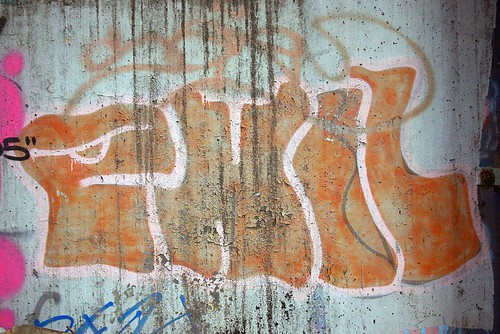 |
| Somewhere behind Mana Museum for Urban Arts on a stanchion supporting the 14th street viaduct, that is, if it's managed to survive all the construction crews that have been mucking around back there. |
With the emergence of Mana Contemporary, Jersey City is set to ride the intersection of two dynamics which could, together, transform Jersey City over the next quarter century. One of these dynamics is about cultural change and growth while the other is about the interaction of culture and urban real estate.
First we talk culture and urban development, and then we discuss Jersey City and Mana Contemporary.
Two Dynamos
One of the best-known dynamics in urban development is the one that begins when artists move in to a dead commercial or industrial neighborhood to get cheap space. The buildings are empty and have large open space well suited for artist’s studios. Services businesses follow the artists – laundries, food stores, restaurants and cafes, and so forth – and then others, with more money to spend on housing, see an upcoming neighborhood and decide to live there. A generation later the artists are priced out of the neighborhood they’d created.
That’s one dynamic. Let’s set that aside for the moment and look at another dynamic, one that’s different and more abstract. This dynamic is about cultural change.
The single best example I can think of is American popular music in the twentieth century, which has been dominated by the interaction between white and black musics. That’s by no means the only dynamic, nor even the only important one, but it’s the one that’s strongest and that’s been doing on the longest, with roots extending back into colonial times.
Thus early in the 20th Century blues and ragtime came bubbling up out of the ground with particular concentrations in New Orleans, Mississippi, Kansas City, and New York City. From this came Swing, the popular music of the 20s, 30s, and into the 40s. Though the most innovative practitioners where black, everyone got in on the act and the audience was mostly white, simply because the white population was and is so much larger than the black. Rock and Roll broke free in the 1950s, first among black musicians and audiences, but then everyone. Hip-hop emerged in the 1980s.
That, of course, is a gross simplification – I run it down in more detail in Music Making History: Africa Meets Europe in the United States of the Blues. The point is simply that we have cultural interaction between two different populations, with different histories and positions in society. A similar dynamic is now operating in the visual arts, and that dynamic is linked to this one in that graffiti is the all-but official visual style of hip-hop.
Graffiti and "Legit" Art
The dynamic relationship between graffiti and the “legit” art world is much like that between black music and white – two-way imitation and borrowing.
Spray-can graffiti arose in New York City and Philadelphia in the late 1960s and early 1970s and had spread around the world by the 1990s–in part because hip-hop took it there. It arose outside the legit art world of galleries, museums, and art schools and maintains a significant “outside” presence to this day. Even the graffiti writers who have gallery representation and have canvases and prints in museum collections insist on maintaining their street cred by doing “illegals.”
It’s the illegal nature of street graffiti that anchors outside the legit art world. And, while some graffiti writers now have art school educations (and may even work as designers with sporting goods, apparel, media and other companies) many writers remain indifferent if not actively hostile to that world. Graffiti has not been assimilated to and absorbed into museum, gallery, and art school culture – though some schools now have studio courses in aerosol art.l
What makes the graffiti/legit dynamic such a powerful one, then, is: 1) graffiti originated outside the legit world and has maintained that status, and 2) graffiti is international, and so has interacted with legit art traditions on every continent. It’s everywhere and remains strong after more than four decades. It’s the most important art form to have emerged in the last half century.
Once graffiti had claimed the streets for (illegal) art, other artists, with different sensibilities and techniques took to the streets. The so-called street artists began gaining prominence in the 1990s. Many of these artists used stencils – Banksy is perhaps the best-known of these – and prints, often quite large, that they pasted on walls. As swing gave birth to bebop, so graffiti gave birth to street art.
Friday, July 11, 2014
Group Dynamics: Jamming Jazz [2498]
About a decade ago I jammed with a bunch of guys – yes, guys – on Manhattan’s upper West Side. None of us were or had been professional musicians, as that term is understood, though some of us had played paying gigs at one time or another. We met in the pianist’s apartment.These are some notes I made back then which speak to the social nature of the music-making itself, as opposed to the socializing that went on around the music-making.
* * * * *
There were five of us regulars, and a floating cast of others. We had three in the rhythm section, piano, drums, and bass, and two horns in the front line, tenor saxophone and trumpet. The general purpose of the session was simply to jam on tunes and have fun, hence our procedures were relatively informal.
Small group jazz is basically a soloist's art (like, for example, classical Indian music). The format for a tune is relatively simple. The horns state the "head" (melody) in the first chorus and in the last chorus. In between you have a bunch of solos. There are various ways this format is spiced up just a bit, but they are relatively minor and aren't necessary to the form.
It is quite common to perform jazz in a piano trio, where you have just piano, drums, and bass. This format tends to be a pianist's gig, e.g. Oscar Peterson, though it can also be a pianist's & bassist's gig, e.g. Bill Evans and Scott LaFaro. By this I mean only that the pianist (or pianist & bassist) is the featured soloist.
Rhythm Section and Front Line
However, quartets and quintets are more common than piano trios (except, of course, in cocktail lounges). Here you add one or two horns to the front line. In this configuration the piano/bass/drums combo becomes known as the rhythm section and the horn or horns becomes the front line. Given that this is a soloist’s art, there is no point in even having such a configuration unless the horn(s) are featured soloists.
In this format the rhythm section is responsible for keeping the "groove" and maintaining the chord progression on which solos are based. The horn(s) play the head and then improvise solos. Musicians in the rhythm section may or may not take solos. The pianist may well, in effect, "retreat" into the rhythm section and leave the bulk of the soloing to the front line. Whether or not this happens is a function of the abilities and interests of the musicians. Finally, if there are two or more horns, they have to coordinate their lines on the head at the beginning and end of the tune.
One of the unwritten rules is that all horns must play on the head; you don't have a situation where one horn plays the head and then all of them solo. I cannot recall ever attending a performance where this rule was violated nor can I think of any recording where it was violated. It surely must happen, but it is rare.
Why not? Think of a performance as a self-contained social occasion. During the opening statement of the head we introduce everyone and say hello. During the final statement of the head we pay our compliments to the hostess and say goodbye. What this means, then, is that if a horn player takes a solo without having played on the head, we don't know who they are or what they're doing at our little soiree. Are they friend or foe? We simply don't know. [Note: There is evidence from brain imaging studies that social areas of the brain are active when people listen to music.]
Jam Sessions
There is however a different, and more informal, playing situation where the norms are different. That is the jam session.
Jam sessions have a long tradition in jazz, complete with accounts of legendary sessions. But jam sessions hardly exist anymore, certainly not in the competitive form often known as "cutting" contests. In such a jam session you have a rhythm section and a parade of horn soloists. Each successive soloist tries to outplay the other, though some of the legendary sessions came down to a battle between only two players. In this format it is not necessary for all the players to perform on the head. You might have half-a-dozen or more horn players. You probably couldn’t get them all on the stage at once – the clubs where these seesions happen have small to very small stages – and the playing probably would be raggedy.
Thursday, July 10, 2014
Subscribe to:
Comments (Atom)

